stop start Hyundai H-1 (Grand Starex) 2004 Owner's Guide
[x] Cancel search | Manufacturer: HYUNDAI, Model Year: 2004, Model line: H-1 (Grand Starex), Model: Hyundai H-1 (Grand Starex) 2004Pages: 273, PDF Size: 11.26 MB
Page 189 of 273
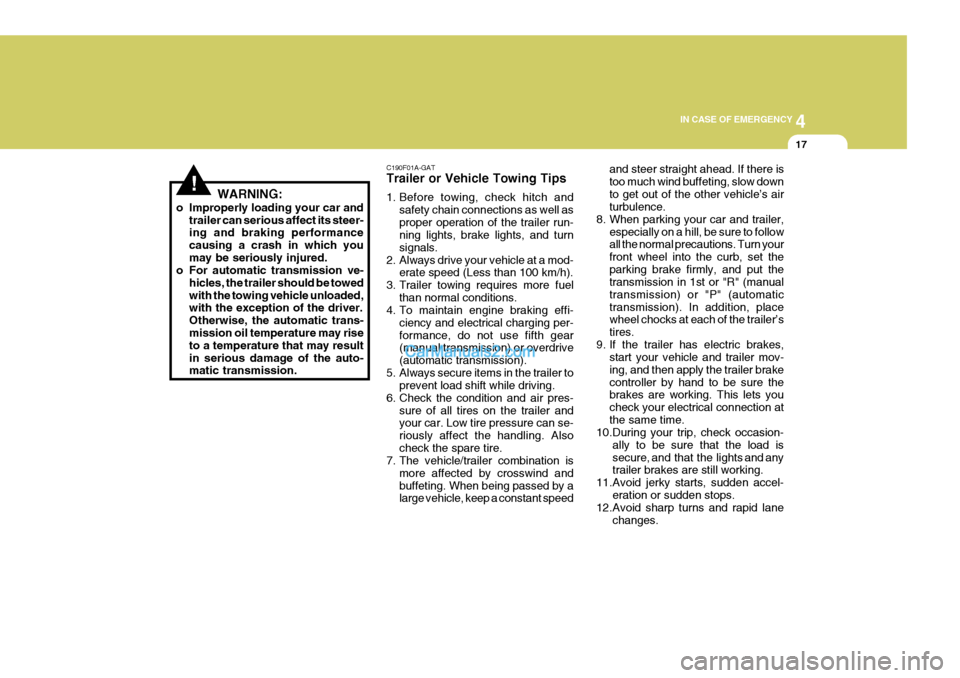
4
CORROSION PREVENTION AND APPEARANCE CARE
17
4
IN CASE OF EMERGENCY
17
!WARNING:
o Improperly loading your car and trailer can serious affect its steer- ing and braking performance causing a crash in which youmay be seriously injured.
o For automatic transmission ve-
hicles, the trailer should be towedwith the towing vehicle unloaded, with the exception of the driver. Otherwise, the automatic trans-mission oil temperature may rise to a temperature that may result in serious damage of the auto- matic transmission. C190F01A-GAT Trailer or Vehicle Towing Tips
1. Before towing, check hitch and
safety chain connections as well as proper operation of the trailer run- ning lights, brake lights, and turn signals.
2. Always drive your vehicle at a mod- erate speed (Less than 100 km/h).
3. Trailer towing requires more fuel than normal conditions.
4. To maintain engine braking effi-
ciency and electrical charging per-formance, do not use fifth gear (manual transmission) or overdrive (automatic transmission).
5. Always secure items in the trailer to prevent load shift while driving.
6. Check the condition and air pres- sure of all tires on the trailer and your car. Low tire pressure can se- riously affect the handling. Alsocheck the spare tire.
7. The vehicle/trailer combination is
more affected by crosswind andbuffeting. When being passed by a large vehicle, keep a constant speed and steer straight ahead. If there is too much wind buffeting, slow downto get out of the other vehicle’s air turbulence.
8. When parking your car and trailer, especially on a hill, be sure to followall the normal precautions. Turn your front wheel into the curb, set theparking brake firmly, and put the transmission in 1st or "R" (manual transmission) or "P" (automatictransmission). In addition, place wheel chocks at each of the trailer’s tires.
9. If the trailer has electric brakes, start your vehicle and trailer mov-ing, and then apply the trailer brakecontroller by hand to be sure the brakes are working. This lets you check your electrical connection atthe same time.
10.During your trip, check occasion-
ally to be sure that the load issecure, and that the lights and any trailer brakes are still working.
11.Avoid jerky starts, sudden accel- eration or sudden stops.
12.Avoid sharp turns and rapid lane
changes.
Page 194 of 273

44IN CASE OF EMERGENCY
22IF THE ENGINE OVERHEATS
CAUTION:
o Do not allow the jumper cable clips to touch one another.
o Do not connect the jumper cable
to the negative terminal of the flat battery. The battery generates explosive gas, and a spark caused whenthe jumper cable is disconnected from the negative terminal could ignite this gas and cause an ex-plosion.
o Be careful that the jumper cable
becomes not caught in the cool-ing fan, etc.
! D030A02A-AAT If your temperature gauge indicates overheating, you experience a loss of power, or hear loud pinging or knock- ing and the engine is probably too hot.If this happens to you, you should:
1. Pull off the road and stop as soon as
it is safe to do so.
2. Place the gear selector lever in "P"
(automatic transmission), or neutral (manual transmission) and set the parking brake. If the air conditioning is on, turn it off.
3. If engine coolant is running out un- der the car or steam is coming outfrom the hood, stop the engine. Donot open the hood until the engine coolant has stopped running or the steaming has stopped. If there is novisible loss of engine coolant and no steam, leave the engine running and check to be sure the enginecooling fan is operating. If the fan is not running, turn the engine off.
the other end to the engine block of the vehicle with the flat batteryat the point farthest from the battery.
8. Start engine as described "Starting the engine" in section 3.
9. After the engine is started, discon- nect the cables in the reverse order.
1. Both batteries must be 12V. The
capacity (Ah) of the battery supply- ing current should not be signifi- cantly below that of the discharged battery.
2. Use only heavy-duty jumper cables.
3. A discharged battery can freeze. A
frozen battery must be thawed out before connecting the jumper cables.
4. There should be no contact be-
tween the two vehicles; otherwisecurrent may flow when the positive terminal is connected.
5. The discharged battery must be correctly connected to the vehicleelectrical system.
6. Run the engine of the vehicle sup- plying current.
7. Connect the jumper cables as fol-
lows:
(1) Connect one end of one jumper cable to the positive terminal of the flat battery, and the other end to the positive terminal of the booster battery.
(2) Connect one end of the other jumper cable to the negative ter-minal of the booster battery, and
Page 214 of 273
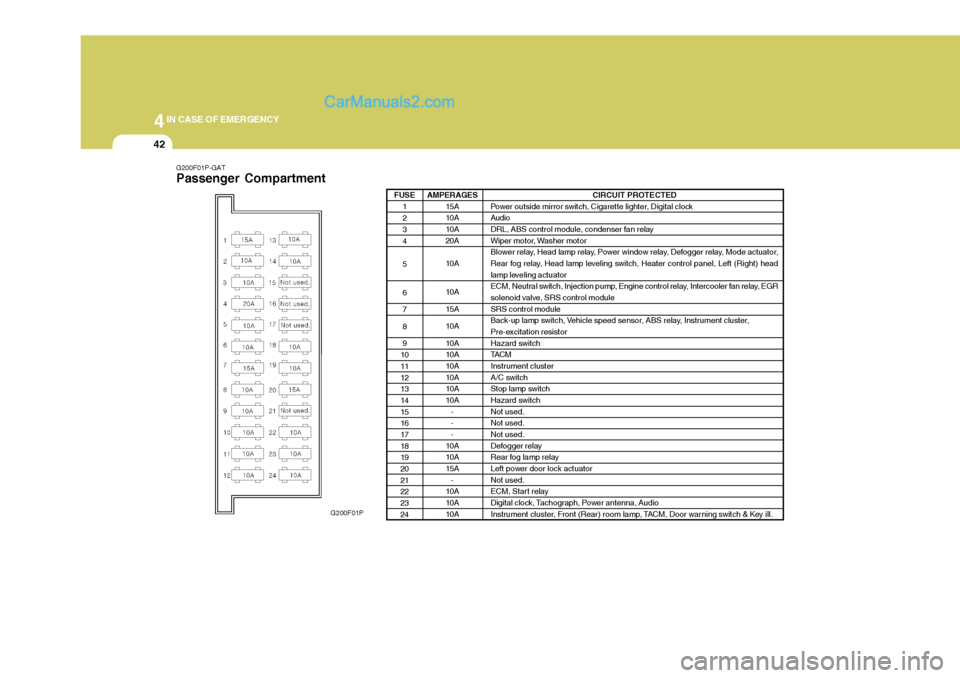
44IN CASE OF EMERGENCY
42
G200F01P-GAT Passenger Compartment
G200F01P CIRCUIT PROTECTED
Power outside mirror switch, Cigarette lighter, Digital clock
Audio
DRL, ABS control module, condenser fan relay
Wiper motor, Washer motor
Blower relay, Head lamp relay, Power window relay, Defogger relay, Mode actuator,
Rear fog relay, Head lamp leveling switch, Heater control panel, Left (Right) head
lamp leveling actuator
ECM, Neutral switch, Injection pump, Engine control relay, Intercooler fan relay, EGR
solenoid valve, SRS control module SRS control module
Back-up lamp switch, Vehicle speed sensor, ABS relay, Instrument cluster,
Pre-excitation resistor
Hazard switch
TA C MInstrument cluster
A/C switch
Stop lamp switch
Hazard switch Not used. Not used.Not used.
Defogger relay
Rear fog lamp relay
Left power door lock actuator Not used.
ECM, Start relay
Digital clock, Tachograph, Power antenna, Audio
Instrument cluster, Front (Rear) room lamp, TACM, Door warning switch & Key ill.
AMPERAGES 15A 10A10A 20A 10A 10A 15A10A10A 10A10A 10A 10A10A---
10A10A15A -
10A10A 10A
FUSE
123 4 5 6 7 8 9
10 1112 13 14 1516 17 1819 20 2122 23 24
Page 231 of 273
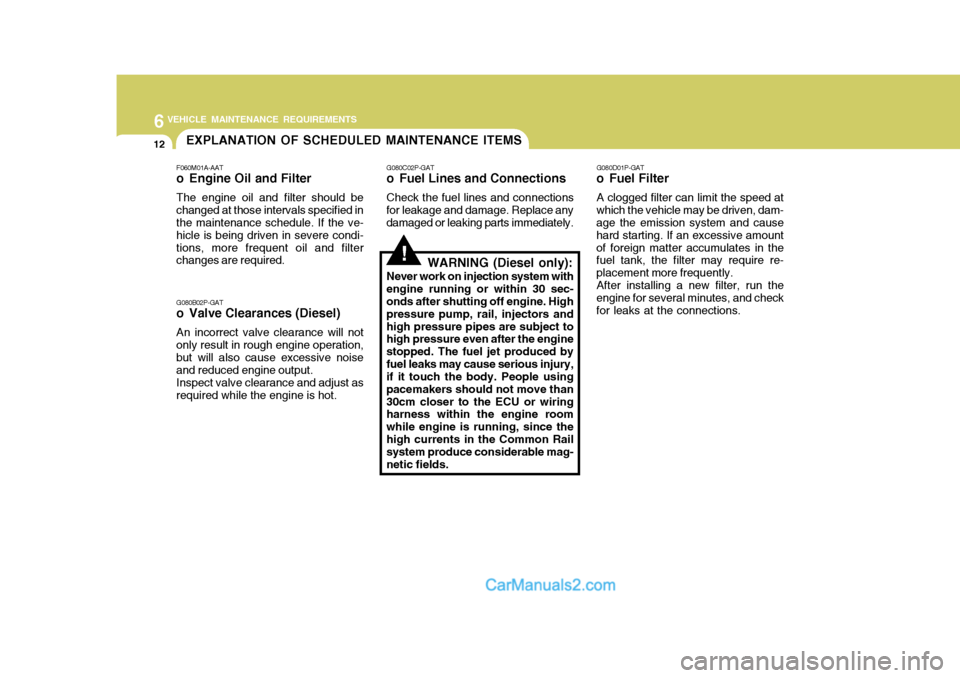
6VEHICLE MAINTENANCE REQUIREMENTS
12EXPLANATION OF SCHEDULED MAINTENANCE ITEMS
F060M01A-AAT
o Engine Oil and Filter The engine oil and filter should be changed at those intervals specified in the maintenance schedule. If the ve- hicle is being driven in severe condi-tions, more frequent oil and filter changes are required. G080B02P-GAT
o Valve Clearances (Diesel) An incorrect valve clearance will not only result in rough engine operation, but will also cause excessive noiseand reduced engine output.Inspect valve clearance and adjust asrequired while the engine is hot. G080C02P-GAT
o Fuel Lines and Connections
Check the fuel lines and connections
for leakage and damage. Replace any damaged or leaking parts immediately. G080D01P-GAT
o Fuel Filter
A clogged filter can limit the speed at
which the vehicle may be driven, dam-age the emission system and cause hard starting. If an excessive amountof foreign matter accumulates in the fuel tank, the filter may require re- placement more frequently. After installing a new filter, run the
engine for several minutes, and checkfor leaks at the connections.
!WARNING (Diesel only):
Never work on injection system with
engine running or within 30 sec- onds after shutting off engine. High pressure pump, rail, injectors and high pressure pipes are subject to high pressure even after the engine stopped. The fuel jet produced byfuel leaks may cause serious injury, if it touch the body. People using pacemakers should not move than30cm closer to the ECU or wiring harness within the engine room while engine is running, since thehigh currents in the Common Rail system produce considerable mag- netic fields.
Page 246 of 273
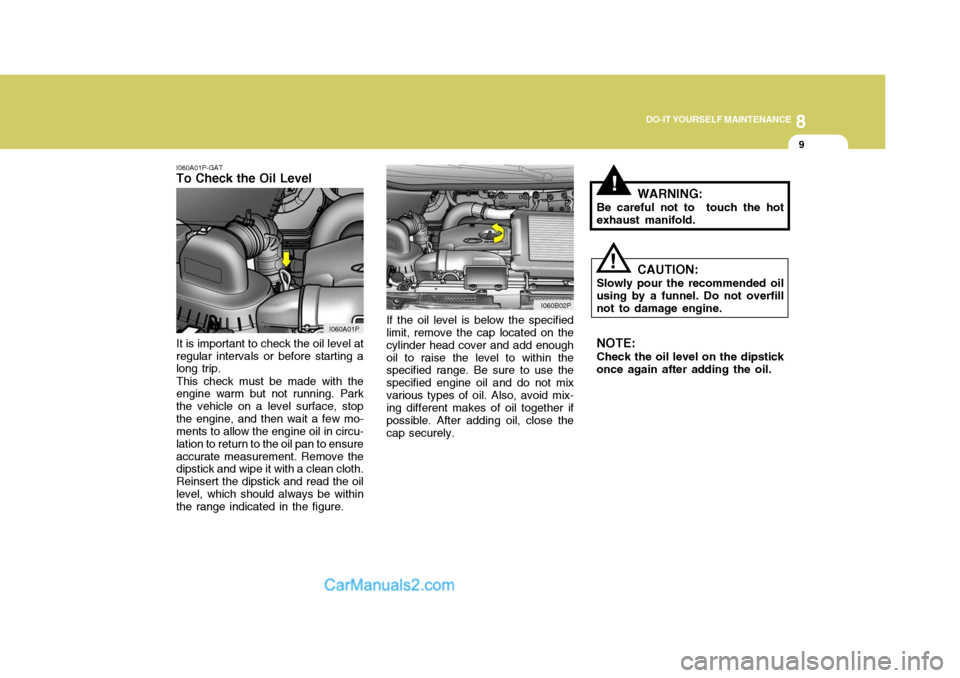
8
DO-IT YOURSELF MAINTENANCE
9
!
I060A01P-GAT
To Check the Oil Level
If the oil level is below the specified limit, remove the cap located on the cylinder head cover and add enoughoil to raise the level to within the specified range. Be sure to use the specified engine oil and do not mixvarious types of oil. Also, avoid mix- ing different makes of oil together if possible. After adding oil, close thecap securely.
It is important to check the oil level at
regular intervals or before starting a long trip.
This check must be made with the
engine warm but not running. Park the vehicle on a level surface, stopthe engine, and then wait a few mo- ments to allow the engine oil in circu- lation to return to the oil pan to ensureaccurate measurement. Remove the dipstick and wipe it with a clean cloth. Reinsert the dipstick and read the oillevel, which should always be within the range indicated in the figure. WARNING:
Be careful not to touch the hot exhaust manifold.
CAUTION:
Slowly pour the recommended oilusing by a funnel. Do not overfillnot to damage engine. NOTE: Check the oil level on the dipstick once again after adding the oil.
!
I060A01P I060B02P
Page 249 of 273
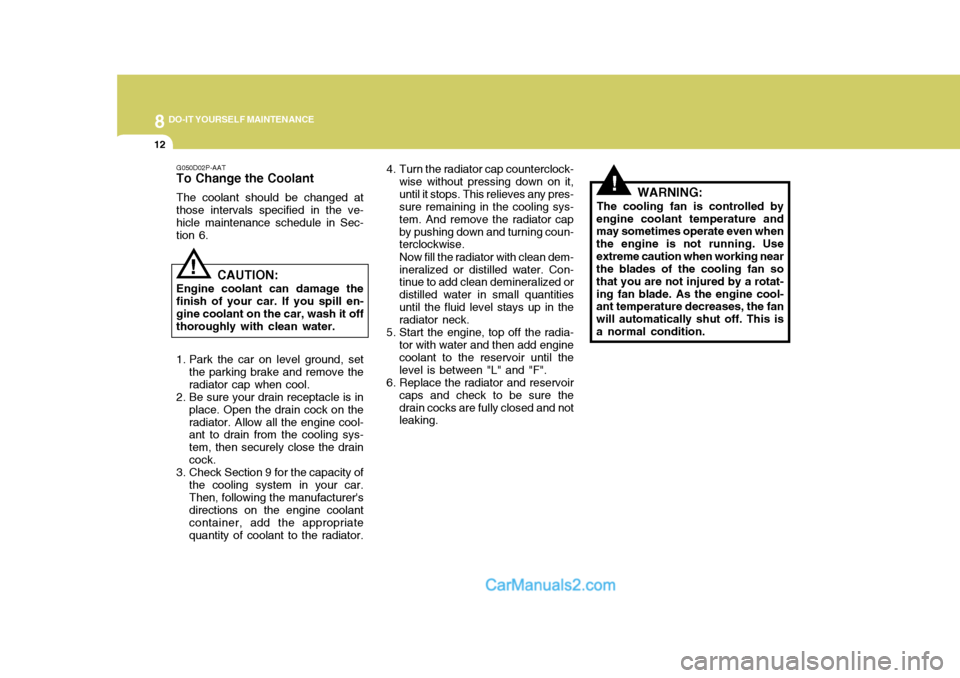
8DO-IT YOURSELF MAINTENANCE
12
!
4. Turn the radiator cap counterclock-
wise without pressing down on it, until it stops. This relieves any pres- sure remaining in the cooling sys- tem. And remove the radiator capby pushing down and turning coun- terclockwise. Now fill the radiator with clean dem- ineralized or distilled water. Con- tinue to add clean demineralized or distilled water in small quantitiesuntil the fluid level stays up in the radiator neck.
5. Start the engine, top off the radia- tor with water and then add engine coolant to the reservoir until thelevel is between "L" and "F".
6. Replace the radiator and reservoir caps and check to be sure thedrain cocks are fully closed and not leaking. WARNING:
The cooling fan is controlled by
engine coolant temperature andmay sometimes operate even when the engine is not running. Useextreme caution when working near the blades of the cooling fan so that you are not injured by a rotat-ing fan blade. As the engine cool- ant temperature decreases, the fan will automatically shut off. This isa normal condition.
G050D02P-AAT To Change the Coolant The coolant should be changed at those intervals specified in the ve- hicle maintenance schedule in Sec- tion 6.
!
CAUTION:
Engine coolant can damage the finish of your car. If you spill en-gine coolant on the car, wash it off thoroughly with clean water.
1. Park the car on level ground, set the parking brake and remove the radiator cap when cool.
2. Be sure your drain receptacle is in
place. Open the drain cock on theradiator. Allow all the engine cool- ant to drain from the cooling sys- tem, then securely close the draincock.
3. Check Section 9 for the capacity of the cooling system in your car.Then, following the manufacturer's directions on the engine coolant container, add the appropriatequantity of coolant to the radiator.
Page 272 of 273
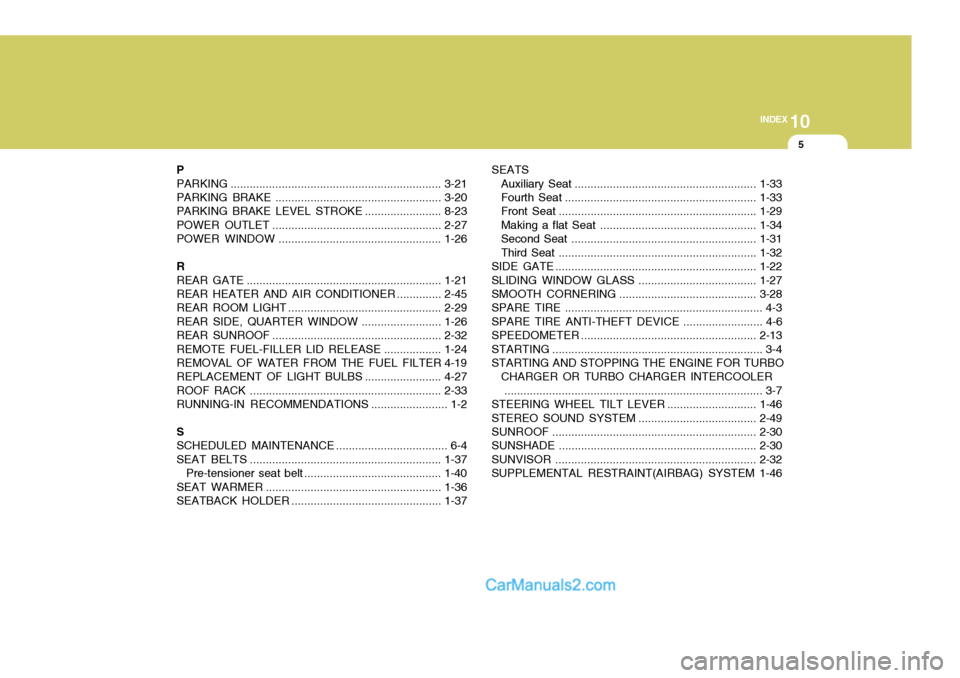
10
INDEX
5
P
PARKING .................................................................. 3-21
PARKING BR AKE.................................................... 3-20
PARKING BRAKE LEVEL STROKE ........................8-23
POWER OUTLET ..................................................... 2-27
POWER WINDOW ................................................... 1-26
RREAR GATE ............................................................. 1-21
REAR HEATER AND AIR CONDITIONER ..............2-45
REAR ROOM LIGHT ................................................ 2-29
REAR SIDE, QUARTER WINDOW......................... 1-26
REAR SUNROOF ..................................................... 2-32
REMOTE FUEL-FILLER LID RELEASE ..................1-24
REMOVAL OF WATER FROM THE FUEL FILTER 4-19
REPLACEMENT OF LIGHT BULBS ........................4-27
ROOF RACK ............................................................ 2-33
RUNNING-IN RECOMMENDATIONS ........................ 1-2
S SCHEDULED MAINTENANCE ................................... 6-4
SEAT BELTS ............................................................ 1-37
Pre-tensioner seat belt ......... ............................. ..... 1-40
SEAT WARMER ....................................................... 1-36
SEATBACK HOLDER ............................................... 1-37SEATS
Auxiliary Seat ......................................................... 1-33
Fourth Seat ............................................................ 1-33
Front Seat .............................................................. 1-29
Making a flat Seat ................................................. 1-34
Second Seat .......................................................... 1-31
Third Seat .............................................................. 1-32
SIDE GATE ............................................................... 1-22
SLIDING WINDOW GLASS .....................................1-27
SMOOTH CORNERING . .......................................... 3-28
SPARE TIRE .............................................................. 4-3
SPARE TIRE ANTI-THEFT DEVICE .........................4-6
SPEEDOMETER ....................................................... 2-13
STARTING .................................................................. 3-4
STARTING AND STOPPING THE ENGINE FOR TURBO
CHARGER OR TURBO CHARGER INTERCOOLER................................................................................. 3-7
STEERING WHEEL TILT LEVER ............................1-46
STEREO SOUND SYSTEM .....................................2-49
SUNROOF ................................................................ 2-30
SUNSHADE .............................................................. 2-30
SUNVISOR ............................................................... 2-32
SUPPLEMENTAL RESTRAINT(AIRBAG) SYSTEM 1-46